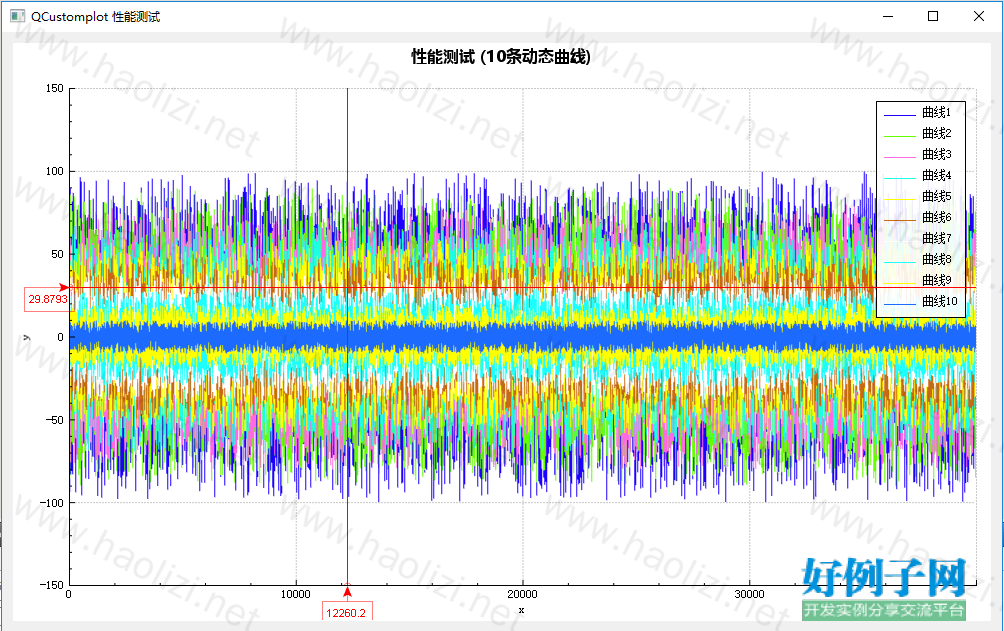实例介绍
【实例截图】Qt动态实时绘图

【核心代码】
LXTracer::LXTracer(QCustomPlot *_plot, TracerType _type, QObject *parent)
: QObject(parent),
m_plot(_plot),
m_type(_type)
{
m_visible = true;
m_tracer = Q_NULLPTR;// 跟踪的点
m_label = Q_NULLPTR;// 显示的数值
m_arrow = Q_NULLPTR;// 箭头
if (m_plot)
{
QColor clrDefault(Qt::red);
QBrush brushDefault(Qt::NoBrush);
QPen penDefault(clrDefault);
// penDefault.setBrush(brushDefault);
penDefault.setWidthF(0.5);
m_tracer = new QCPItemTracer(m_plot);
m_tracer->setStyle(QCPItemTracer::tsCircle);
m_tracer->setPen(penDefault);
m_tracer->setBrush(brushDefault);
m_label = new QCPItemText(m_plot);
m_label->setLayer("overlay");
m_label->setClipToAxisRect(false);
m_label->setPadding(QMargins(5, 5, 5, 5));
m_label->setBrush(brushDefault);
m_label->setPen(penDefault);
m_label->position->setParentAnchor(m_tracer->position);
// m_label->setFont(QFont("宋体", 8));
m_label->setFont(QFont("Arial", 8));
m_label->setColor(clrDefault);
m_label->setText("");
m_arrow = new QCPItemLine(m_plot);
QPen arrowPen(clrDefault, 1);
m_arrow->setPen(penDefault);
m_arrow->setLayer("overlay");
m_arrow->setClipToAxisRect(false);
m_arrow->setHead(QCPLineEnding::esSpikeArrow);//设置头部为箭头形状
switch (m_type)
{
case XAxisTracer:
{
m_tracer->position->setTypeX(QCPItemPosition::ptPlotCoords);
m_tracer->position->setTypeY(QCPItemPosition::ptAxisRectRatio);
m_tracer->setSize(7);
m_label->setPositionAlignment(Qt::AlignTop | Qt::AlignHCenter);
m_arrow->end->setParentAnchor(m_tracer->position);
m_arrow->start->setParentAnchor(m_arrow->end);
m_arrow->start->setCoords(0, 20);//偏移量
break;
}
case YAxisTracer:
{
m_tracer->position->setTypeX(QCPItemPosition::ptAxisRectRatio);
m_tracer->position->setTypeY(QCPItemPosition::ptPlotCoords);
m_tracer->setSize(7);
m_label->setPositionAlignment(Qt::AlignRight | Qt::AlignHCenter);
m_arrow->end->setParentAnchor(m_tracer->position);
m_arrow->start->setParentAnchor(m_label->position);
m_arrow->start->setCoords(-20, 0);//偏移量
break;
}
case DataTracer:
{
m_tracer->position->setTypeX(QCPItemPosition::ptPlotCoords);
m_tracer->position->setTypeY(QCPItemPosition::ptPlotCoords);
m_tracer->setSize(5);
m_label->setPositionAlignment(Qt::AlignLeft | Qt::AlignVCenter);
m_arrow->end->setParentAnchor(m_tracer->position);
m_arrow->start->setParentAnchor(m_arrow->end);
m_arrow->start->setCoords(20, 0);
break;
}
default:
break;
}
setVisible(false);
}
}
LXTracer::~LXTracer()
{
if(m_plot)
{
if (m_tracer)
{
m_plot->removeItem(m_tracer);
}
if (m_label)
{
m_plot->removeItem(m_label);
}
if (m_arrow)
{
m_plot->removeItem(m_arrow);
}
}
}
void LXTracer::setPen(const QPen &pen)
{
if(m_tracer)
{
m_tracer->setPen(pen);
}
if(m_arrow)
{
m_arrow->setPen(pen);
}
}
void LXTracer::setBrush(const QBrush &brush)
{
if(m_tracer)
{
m_tracer->setBrush(brush);
}
}
void LXTracer::setLabelPen(const QPen &pen)
{
if(m_label)
{
m_label->setPen(pen);
m_label->setBrush(Qt::NoBrush);
m_label->setColor(pen.color());
}
}
void LXTracer::setText(const QString &text)
{
if(m_label)
{
m_label->setText(text);
}
}
void LXTracer::setVisible(bool vis)
{
m_visible = vis;
if(m_tracer)
{
m_tracer->setVisible(m_visible);
}
if(m_label)
{
m_label->setVisible(m_visible);
}
if(m_arrow)
{
m_arrow->setVisible(m_visible);
}
}
void LXTracer::updatePosition(double xValue, double yValue)
{
if (!m_visible)
{
setVisible(true);
m_visible = true;
}
if (yValue > m_plot->yAxis->range().upper)
{
yValue = m_plot->yAxis->range().upper;
}
switch (m_type)
{
case XAxisTracer:
{
m_tracer->position->setCoords(xValue, 1);
m_label->position->setCoords(0, 15);
m_arrow->start->setCoords(0, 15);
m_arrow->end->setCoords(0, 0);
setText(QString::number(xValue));
break;
}
case YAxisTracer:
{
m_tracer->position->setCoords(0, yValue);
m_label->position->setCoords(-20, 0);
// m_arrow->start->setCoords(20, 0);
// m_arrow->end->setCoords(0, 0);
setText(QString::number(yValue));
break;
}
case DataTracer:
{
m_tracer->position->setCoords(xValue, yValue);
m_label->position->setCoords(20, 0);
setText(QString("x:%1,y:%2").arg(xValue).arg(yValue));
break;
}
default:
break;
}
}
LXTraceLine::LXTraceLine(QCustomPlot *_plot, LineType _type, QObject *parent)
: QObject(parent),
m_type(_type),
m_plot(_plot)
{
m_lineV = Q_NULLPTR;
m_lineH = Q_NULLPTR;
initLine();
}
LXTraceLine::~LXTraceLine()
{
if(m_plot)
{
if (m_lineV)
{
m_plot->removeItem(m_lineV);
}
if (m_lineH)
{
m_plot->removeItem(m_lineH);
}
}
}
void LXTraceLine::initLine()
{
if(m_plot)
{
QPen linesPen(Qt::red, 1, Qt::SolidLine);
if(VerticalLine == m_type || Both == m_type)
{
m_lineV = new QCPItemStraightLine(m_plot);//垂直线
m_lineV->setLayer("overlay");
m_lineV->setPen(linesPen);
m_lineV->setClipToAxisRect(true);
m_lineV->point1->setCoords(0, 0);
m_lineV->point2->setCoords(0, 0);
}
if(HorizonLine == m_type || Both == m_type)
{
m_lineH = new QCPItemStraightLine(m_plot);//水平线
m_lineH->setLayer("overlay");
m_lineH->setPen(linesPen);
m_lineH->setClipToAxisRect(true);
m_lineH->point1->setCoords(0, 0);
m_lineH->point2->setCoords(0, 0);
}
}
}
void LXTraceLine::updatePosition(double xValue, double yValue)
{
if(VerticalLine == m_type || Both == m_type)
{
if(m_lineV)
{
m_lineV->point1->setCoords(xValue, m_plot->yAxis->range().lower);
m_lineV->point2->setCoords(xValue, m_plot->yAxis->range().upper);
}
}
if(HorizonLine == m_type || Both == m_type)
{
if(m_lineH)
{
m_lineH->point1->setCoords(m_plot->xAxis->range().lower, yValue);
m_lineH->point2->setCoords(m_plot->xAxis->range().upper, yValue);
}
}
}
标签: Qt
小贴士
感谢您为本站写下的评论,您的评论对其它用户来说具有重要的参考价值,所以请认真填写。
- 类似“顶”、“沙发”之类没有营养的文字,对勤劳贡献的楼主来说是令人沮丧的反馈信息。
- 相信您也不想看到一排文字/表情墙,所以请不要反馈意义不大的重复字符,也请尽量不要纯表情的回复。
- 提问之前请再仔细看一遍楼主的说明,或许是您遗漏了。
- 请勿到处挖坑绊人、招贴广告。既占空间让人厌烦,又没人会搭理,于人于己都无利。
关于好例子网
本站旨在为广大IT学习爱好者提供一个非营利性互相学习交流分享平台。本站所有资源都可以被免费获取学习研究。本站资源来自网友分享,对搜索内容的合法性不具有预见性、识别性、控制性,仅供学习研究,请务必在下载后24小时内给予删除,不得用于其他任何用途,否则后果自负。基于互联网的特殊性,平台无法对用户传输的作品、信息、内容的权属或合法性、安全性、合规性、真实性、科学性、完整权、有效性等进行实质审查;无论平台是否已进行审查,用户均应自行承担因其传输的作品、信息、内容而可能或已经产生的侵权或权属纠纷等法律责任。本站所有资源不代表本站的观点或立场,基于网友分享,根据中国法律《信息网络传播权保护条例》第二十二与二十三条之规定,若资源存在侵权或相关问题请联系本站客服人员,点此联系我们。关于更多版权及免责申明参见 版权及免责申明



网友评论
我要评论